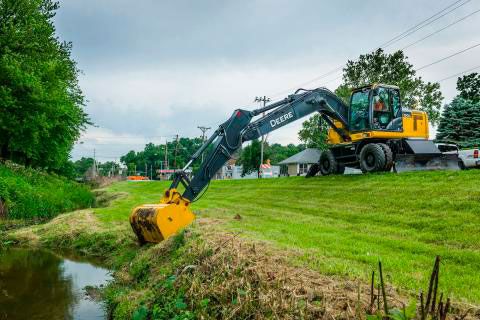Excavating Roadside Ditches
If you had a parent like mine you may have heard this when you were growing up: “The world needs ditch diggers too.” Well, as it turns out, roadside ditches and relief culverts really are a common job that are essential to well-functioning drainage systems for many kinds of roads. They are quite effective at diverting water from in-sloping road surfaces with minimal damage, but you need the right machinery to create them.
Ditch And Culvert Basics
A roadside drainage ditch or relief culvert is needed any place that lacks natural drainage; this leaves both road surfaces and surrounding cut or fill slopes vulnerable. These move water onto a stable area below the road by gathering it in a ditch and then taking it under the road grade using gravity. But when these ditches are installed improperly, they create stream sediment, eventually damaging the entire area; you need to be sure you know how this works.

Tools Of The Trade
Roadside ditches and relief culverts should be built using a bulldozer or excavator. Any permanent relief structures, especially those built in wetlands and other areas with significant amounts of water, must be at least 12 inches in diameter. Other dimensions and the spacing of the ditch will be determined based on the length you need from the structure, the texture of the soil, how much water flow you anticipate, and other details.
The Planning Stage
In addition to the choosing your depth and basic route, selecting your equipment and tools, equipment, and designing your draining ditch or culvert, there are several planning steps you should take to ensure success. First, make sure that your intended route will work properly without causing harm. If you undermine roadways or other structures they may collapse, and damaging roots of bushes and trees can kill them. Next, plan for shoring up the sides of your ditch and remove any water from the area; if it is very wet you may need a pump. Finally, deal with local utilities. Call about communications, electric, gas, and water pipes in the area to make sure you won’t run into or damage them.
Decide what kind of excavator you will need for this job. Your dig depth, width and length measurements should give you an idea of what kind of heavy equipment rental will be right for you. For most residential roadside ditches, a mini excavator rental would be ideal. Heavier excavators are useful for larger projects and wider ditches, like those required for geothermal wells and foundations.
How you should handle roadside vegetation as you construct your roadside ditch or relief culvert is going to vary based on your location, local laws and regulations, and the physical attributes of the area. Obviously your goal is to create a safe, functional drainage system, and depending on the vegetation that’s present there may be different ways to do that. As you work remember to spare desirable, local vegetation that can help you with runoff while ensuring it does not interfere with your ditch, and save small plants so you can replant them elsewhere.
How To Build
First remove 10 to 20 centimeters of topsoil and store it separately at no more than 1 to 1.5m in height so you don’t contaminate or compact it. Line your excavator up with the edge of the ditch and begin digging. Beware of avoiding careful to cave in of the embankments. Your first cut should be deep enough to serve as a guide for the rest of the trench, or to the available reach of the machine (and then adjust that cut to the right depth). Move the soil you dig out as far from the excavation as you can. This helps to maintain a safe workspace and also helps prevent cave ins caused by the weight of the excess soil. Dig along the ditch’s length and check the depth and other dimensions with a professional level as you go until the entire length is complete. Do any smoothing or grading necessary and ensure the embankments are stable.
A Final Word
Remember, roadside ditches and relief culverts are projects that you can handle with the right equipment. Your supplier should be able to help you make sure your equipment will work.

